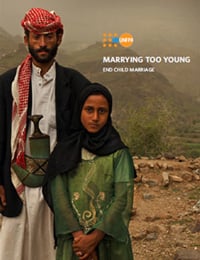BANGKOK – Across Asia today, advocacy events marking the first International Day of the Girl Child will highlight the widespread practice of child marriage and call for scaled-up efforts to empower girls, safeguard their rights, and allow them to stay in school.
Globally, about half of all girls who marry before age 18 are from five South Asian countries. While efforts to end child marriage are having an impact, two thirds of all girls are married by 18 in Bangladesh, 47 per cent in India (concentrated in five states), 41 per cent in Nepal, 39 per cent in Afghanistan, 24 per cent in Pakistan.*

Child marriage violates girls’ rights, deprives them of their childhood, disrupts their education, jeopardizes their health and limits their opportunities. Bearing children before their bodies are mature puts young mothers and their infants at risk of life-threatening health consequences. Complications from pregnancy and childbearing are the leading cause of death among girls aged 15-19.
Several factors fuel child marriage, including the low social status of women, poverty and the lack of economic opportunities for girls in rural areas. Various cultural, traditional and religious beliefs are used to justify the practice. Laws against child marriage exist in most countries but are poorly enforced.
Numerous nongovernmental organizations, community groups and UN agencies working to end child marriage are holding events today. In addition, UNFPA, the United Nations Population Fund, will release a new report on the prevalence of the practice worldwide.
UNFPA offices in Afghanistan, Bangladesh, India, Pakistan and Nepal, among others, are helping to organize press conferences and public forums with policy makers and civil society representatives.
In these countries and regionally, UNFPA offices and partner agencies are assisting governments and supporting policy research and advocacy efforts aimed at: enforcing existing legislation and raising the age of marriage to 18; strengthening birth and marriage registration systems; keeping girls in school through post-primary level; mobilizing communities to address the root causes of child marriage; empowering girls with information, skills and services, including on reproductive health; involving men and boys in opposing child marriage; and ensuring that married girls have access to life-saving maternal health services.
“No social, cultural or religious rationale for child marriage can possibly justify the damage these marriages do to young girls and their potential,” said UNFPA Executive Director, Dr. Babatunde Osotimehin.
*Note: This paragraph has been amended to correspond to data in the newly released UNFPA report, Marrying Too Young: End Child Marriage.

